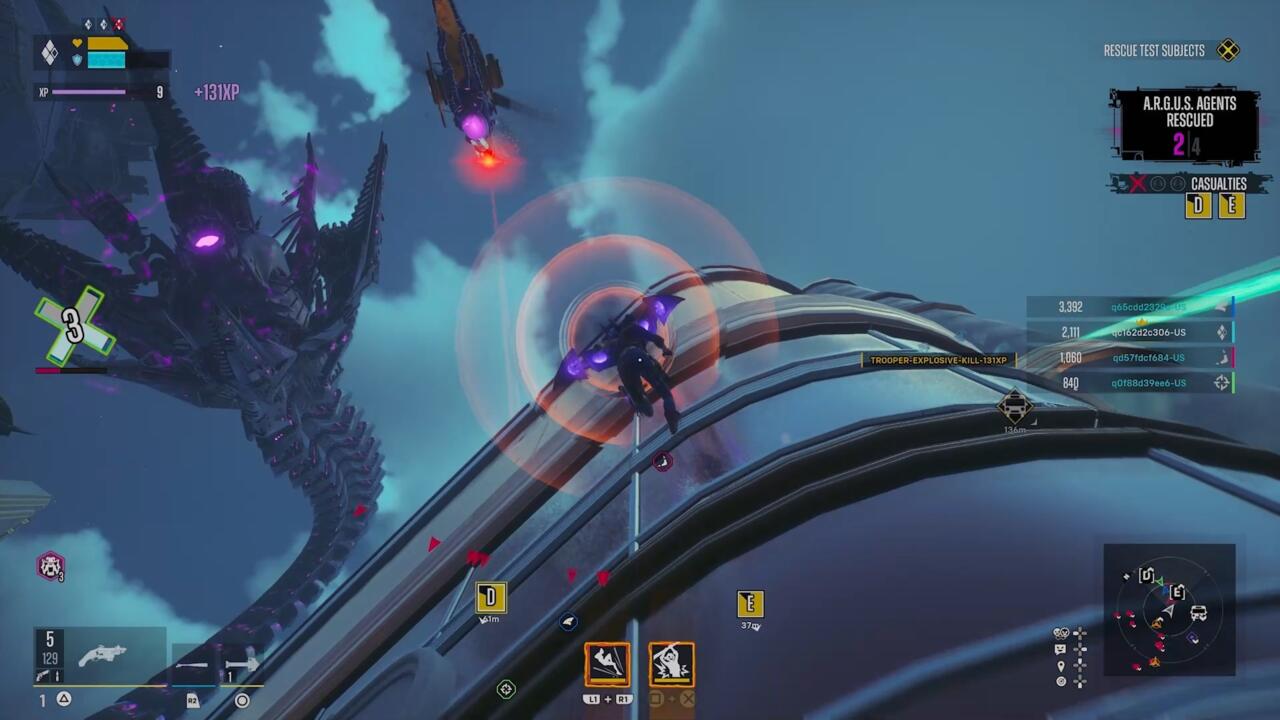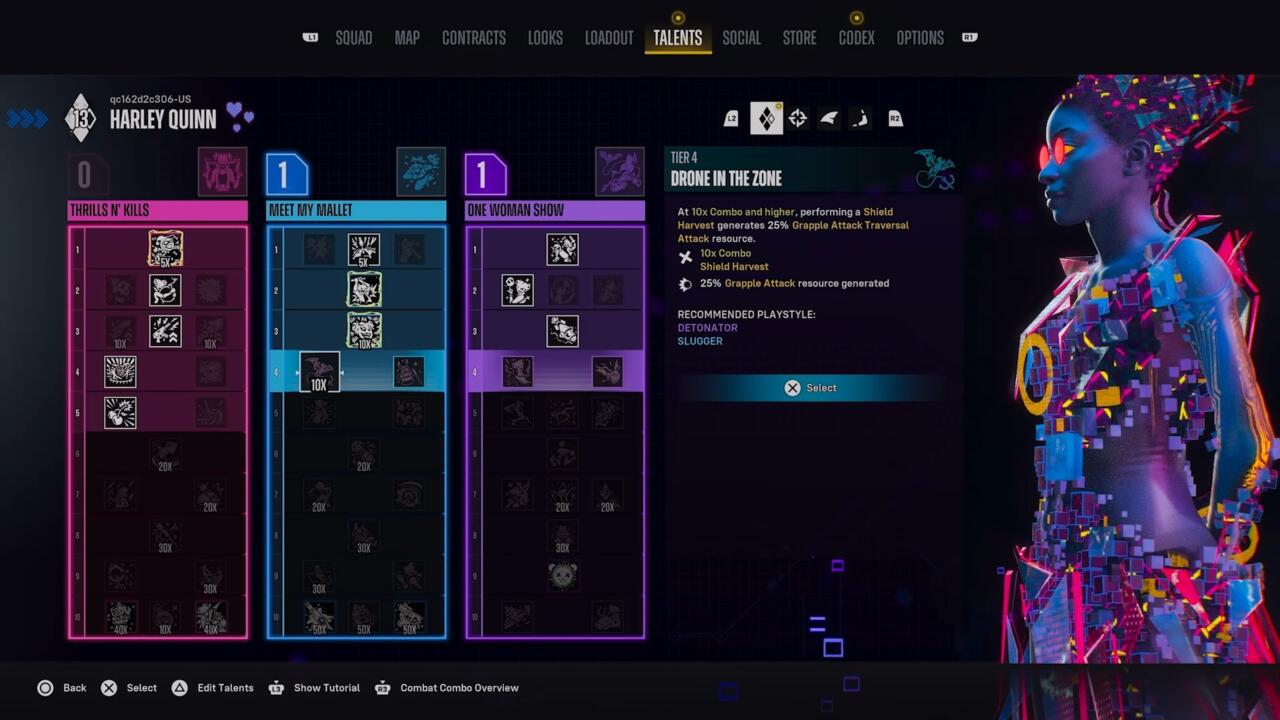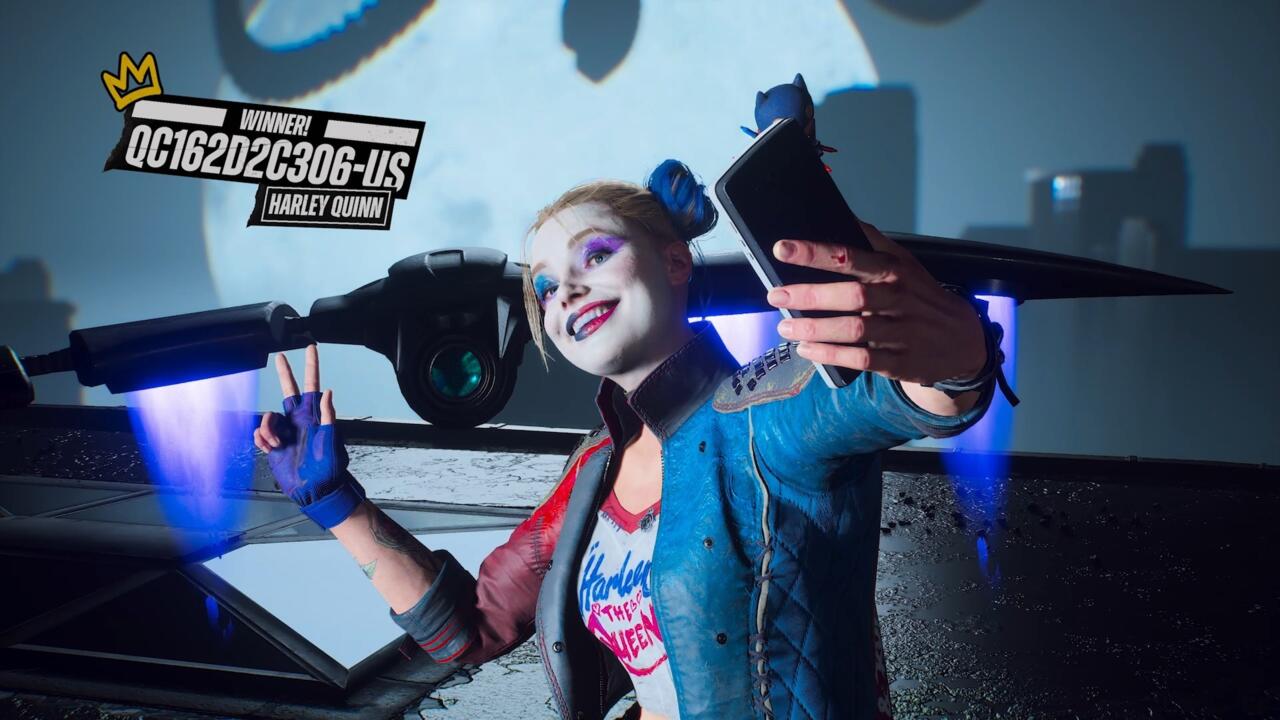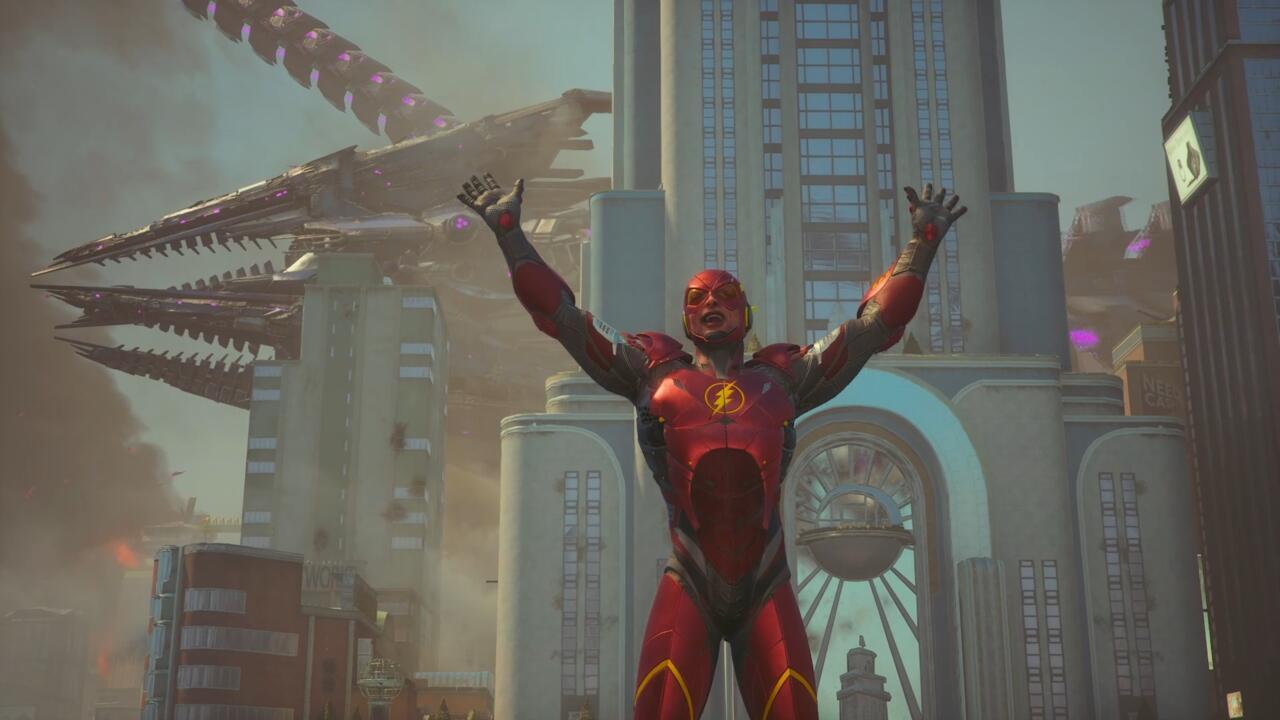With Suicide Squad: Kill the Justice League, developer Rocksteady Studios is hoping to do for the live-service genre what its Batman series did for melee action games. Batman: Arkham Asylum set a standard for beatdown combat that has influenced plenty of developers since its release in 2009, and Batman: Arkham City did the same for both large-scale fights and an open-world setting. Though Suicide Squad is pretty different--it's a co-op third-person shooter--Rocksteady looks to bring the same speed, fluidity, and grace in its combat to make something just as captivating as the Arkham games were.
I recently spent about five hours playing an early portion of Suicide Squad at a hands-on event in Los Angeles, and I came away unsure if its mix of live-game content, loot-shooter RPG systems, and shooter combat could capture lightning in a bottle the way the Arkham games did. It's clear what Rocksteady is attempting is ambitious and there are things about it that work well, but a snapshot look at the game wasn't enough to get the hang of its systems or see whether it can eventually balance all of the elements that feel, on first blush, like they pull Suicide Squad in different directions.
The portion I played picked up at the start of the story, when protagonists Harley Quinn, Deadshot, King Shark, and Captain Boomerang are forced to take on a pretty awful-sounding mission. Metropolis has been invaded by the villain Brainiac, who has used weird technology to take over the minds of most of DC's best superheroes. Batman, Superman, The Flash, and The Green Lantern have all been corrupted, and they're actively helping Brainiac turn any surviving Metropolis residents into twisted gooey soldiers. Before anyone can even think about how to deal with this alien invasion, they need threats such as Superman and Batman out of the way.
The setup provides an open-world environment and active warzone in Metropolis, offering a cityscape with lots of variety in its skyline to provide rooftops, billboards, elevated train tracks, and a host of other elements for you to grapple to, climb up, and leap off. It also fills that world with an endless supply of alien soldiers to fight and an invasion you'll be working to put down for the foreseeable future.
Playing keepy-uppy

The gist of Suicide Squad is a four-player cooperative open-world experience, with RPG progression systems for each of its four characters and piles of guns to chase to increase your overall power. Suicide Squad sets itself apart by mixing quick, aerial traversal with its shooting mechanics; you're meant to spend most of your time in the air combining acrobatics with explosions and gunfire, zipping between streets and rooftops with a combination of moves that feel and operate differently based on which character you use.
Each character starts the game by stealing useful items from the Justice League's abandoned Hall of Justice, which inform their movement abilities. Harley grabs some of Batman's grapple gear, Deadshot dons a jetpack, and Captain Boomerang snags a gauntlet that gives him short bursts of Flash-like speed. (King Shark, the most actually super of the squad, just leaps around, pounding on people.) While each character can use all the different weapon types, which character you choose determines how you move around the battlefield, with their own distinct style and gameplay feel, and some weapons combine better with their approaches and abilities than others.
"When you look at the squad themselves, you kind of expect guns, explosions, chaos. So that's one aspect," advanced combat designer Noel Chamberlain said in an interview with GameSpot. "And then, the other aspect is to keep that Rocksteady DNA going, of taking on challenges and making something genre-defining. We didn't want to do the same thing that we've already done before. So, we wanted a new challenge and I think marrying traversal combat and our other many systems in the game ... but taking the same philosophy of being able to enter those flow states to effortlessly go from traversing Metropolis into combat and back out, it's definitely something that I think people expect from Rocksteady."
I played almost the entire session as Harley Quinn, whose traversal relies on using a Batman-like grapple hook on walls and, when no architecture presents itself, on an ever-present Bat-drone that follows her around. Each character has several moves you need to loop together to keep yourself going through combat. For example, in Harley's case, you can only swing from the drone every so often, and its cooldown lengthens the more times you swing without grappling to something else. That means that for any real distance between buildings or over a gap, you need to chain moves like double-jumps and dashes together with drone swings and building grapples to keep yourself going. The trick is to constantly link different traversal moves together in a thoughtful way because as soon as you stop paying attention, you'll lose your momentum.

For my part, traversal and combat during the preview never felt quite as effortless or flowing as I'd hoped they would. There were times when I got the hang of Harley, swinging deftly from location to location and wailing on enemies, and the longer the event went on, the better combat felt. But things were also always a little clunky. I felt like I kept swinging into walls, or losing track of my next grapple point, or forgetting one of Harley's moves and breaking the movement chain at a key moment.
My struggles could very well be a result of the format of this sort of preview. Suicide Squad is full of the kinds of systems that work best when you have time to acclimate yourself to them, ideally through the natural opening of the game. At a preview event, circumstances are never ideal to climb a learning curve like that. Though I eventually started to feel more comfortable with the traversal systems, I never got to a point where movement and combat felt quick and natural.
Build beneficence
Once you start to get the hang of how Suicide Squad is meant to be played, though, combat can be frenetic and fun, particularly when you take advantage of different build synergies. Each character has three skill trees you can progress down, along with the ability to respec them between missions without any costs. That means you can put together some pretty different gameplay approaches to keep things varied or fill a role on your team. During my session, Rocksteady set me up with a grenade-centric build for Harley, boosting explosive damage and setting me up with weapons, abilities, and equipment that dropped grenades when I skillfully linked parkour movements, like going from a mid-air swing into a slide upon hitting the ground.
The result had lots of things blowing up. Pushing those different elements of Harley's build made combat feel not only different from what I'd already tried but highly effective in making disparate elements of combat and traversal feel important to your battle strategy. Now I wasn't just trying to keep my swings smooth for efficient travel; I was hoping to make the most out of different moves for maximum carnage.

Production manager Jack Hackett said Rocksteady wants the loot system to feature more meaningful choices than comparing how a gun might boost a few percentage points of this or that character stat. I only got a brief glimpse at how character builds will work in Suicide Squad, but my impression was that the systems allow for a lot of interesting customization that goes beyond the usual spreadsheet-style min-maxing. Loot-shooters often have players finding and discarding a ton of guns they don't really need, so this focus on making sure items have distinct traits and uses should keep the looting part of the formula interesting and engaging.
Lost in the live game
Our portion of the game included a fairly early part of the story, showing the origin of the squad and providing a fair number of funny cutscenes and character moments where a group of goofy misanthropes bounce off one another. In terms of gameplay, the preview was mostly aimed at introducing players to the kinds of events they can find in Metropolis and play over and over again, giving more of a moment-to-moment feel of what to expect over time. Those activities carried objectives such as keeping enemies away from computer terminals for a set amount of time or ferrying civilians scattered around a battlefield to the safety of an evacuation bus.
These events and battles felt a bit generic, especially in comparison to Suicide Squad's main story moments that are more akin to what Arkham fans are used to seeing. Though each mission had different objectives, they all had the same basic gist of battling waves of enemies while swinging back and forth between rooftops. We got a very brief look at what Suicide Squad will be like, and Rocksteady said players can expect more bespoke, story-driven missions as they work through the campaign. But the repeatable open-world events during the preview session were nothing anyone with experience playing loot-shooter games hasn't seen before.
One way Rocksteady works to keep that repeatable content fresh, however, is with ongoing friendly competitions. While players are always working toward the same objective, Suicide Squad tracks how much each person is contributing in a given activity, and each of these events ends with a splash screen spotlighting the winner. It gives everything you do a bit of a Mario Party vibe, and what's more, the person who wins becomes the team's new squad leader, which gives them control over what activity your group does next.

Chamberlain said the combination of cooperation and competition plays into both the nature of four-player gameplay and the sense that you're taking control of a team of misfit bad guys. Both cooperative and competitive design elements help push the whole team to accomplish their goals, even if they have differing reasons for doing so.
"We kind of call it 'coopetition,'" Chamberlain explained. "The squad is very chaotic by nature, right? But we don't want the players to feel left out or to be frustrated with things. So there are things in the world that need to happen--if you go down, someone has to revive you, and in terms of the narrative, Amanda Waller can't let any of the squad die. So if you abandon a squadmate, you all die. ... We've got RPG elements, like putting enemies into slow motion, that make it easier for your teammates to shoot them. But then we also have the opposite of that. You can send rival taunts to players that essentially give them the middle finger because you beat their leaderboard score. So we really wanted to ensure the players have a nice experience while keeping the spirit of the chaotic squad, who want to survive together, but may not necessarily like each other."
Though Rocksteady wouldn't talk about the endgame players can expect from Suicide Squad once they complete the game, Hackett did mention that seasonal content updates and additional characters released after launch will be free. He also talked about Rocksteady's vision for the future of the game, which includes delving into additional DC characters and lore that might not otherwise make it into a video game.
Killing The Flash
Our play session culminated with a boss fight against The Flash. Dealing with the super-speedy hero required charging up a special device we'd found through the story by activating Suicide Squad's counterattack ability, meant to be somewhat similar to Batman's ability to read attacks coming and counter enemies in the Arkham games. Comic book-esque lightning bolts appear over Flash's head, you hit a particular button, and you zap him to stop the attack he was about to use on you while also charging the device. When it's fully charged, you're able to shoot Flash and damage him.
The fight felt a bit clunky, and it was again difficult to tell if the issue was with the boss battle's design or that my team hadn't had the time to develop the movement skills Suicide Squad relies on. Flash's quick movements around the battlefield, a chunk of a defunct theme park, made it hard to track the action, especially because he would vanish and turn up on a rooftop on the far side of the arena. Flash eventually would speed around to create massive tornadoes the team needed to dodge, but it was tough to tell where a lot of his attacks were coming from or when and why you were taking damage. We eventually beat him, but it was more about wearing the boss down and not the result of particular teamwork or strategy on our part.

My biggest takeaway from Suicide Squad is that I want to play it in the way it's meant to be played. When the combat and traversal systems come together, especially when you can start to customize a particular build like one that has you constantly throwing souped-up grenades and leaving them in your wake as you slide away from danger, they're fluid and exciting. But there's a lot to get the hang of here, and falling out of the flow or losing track of its many ins and outs killed the momentum fairly often.
That also goes for the story. A slice of live-service missions intercut with funny narrative beats suggested a game that was attempting a little bit of both but achieving neither very well. I'm excited to continue with the main story, which has lots of funny moments and great interactions between the protagonists in particular. The idea of trying to take down the Justice League, knowing the kind of power they wield as you head into battle against them, is a great premise. But open-world missions where characters bark at you over the radio about how enemies are attacking point A or point B over and over don't seem to be breaking the mold, especially when plenty of live open-world games now exist with a lot of the same kinds of content. Rocksteady may hope to define another genre with Suicide Squad: Kill The Justice League, but we'll need to see more of it to determine whether it can actually deliver on that ambition.





